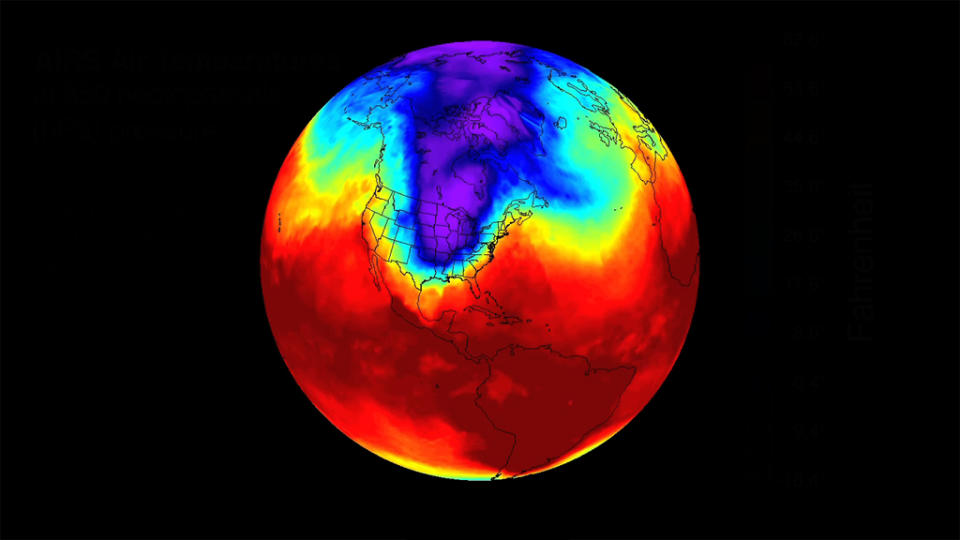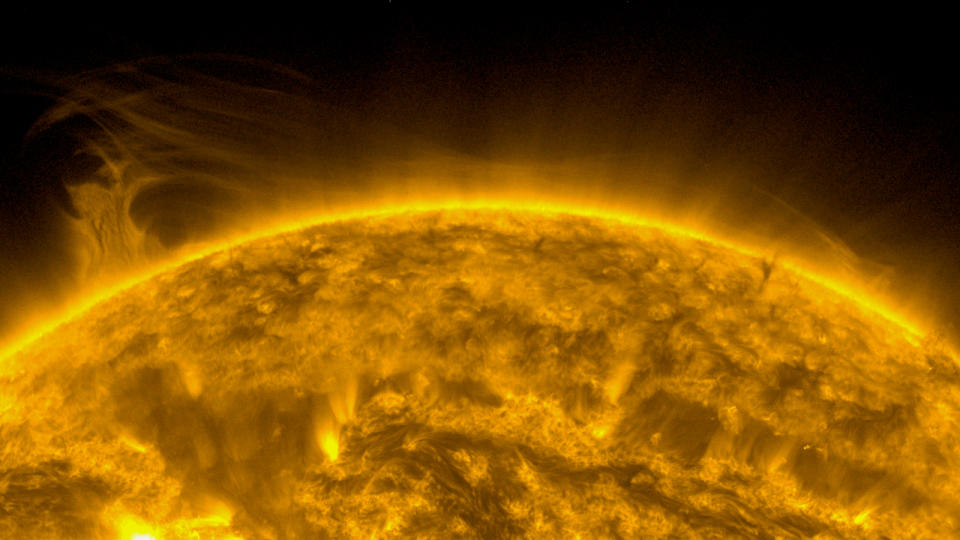Massive filament swirls into a 'polar vortex' on the Sun, wowing scientists
New images from NASA have revealed an immense band of plasma apparently swirling around the Sun's north pole. This 'solar polar vortex' is something new for solar scientists,
Here on Earth, the polar vortex is a not some rare phenomenon. It has been around since the planet's atmosphere first formed, and it was first described by scientists in the mid-1800s. Over the past decade, ever since the winter of 2013-2014, it has become something of a 'buzz word' in the media and weather forecasts.

This simulation shows the deep freeze that plunged down over Canada and the United States in December 2013 and early January of 2014. Credit: NASA's Goddard Scientific Visualization Studio
Thanks to telescopes and spacecraft, we have also seen polar vortices on Venus, Mars, Jupiter, and Saturn. Even Saturn's moon, Titan, appears to have one.
And now it seems that we can add the Sun to that list.
Images from NASA's Solar Dynamics Observatory, captured on February 2-3, 2023, appear to show a massive filament of solar plasma being stretched into a swirling vortex around the Sun's north pole.
"This is honestly the first time I have seen this kind of thing at the Sun's poles," solar physicist Dr. Scott McIntosh, deputy director of the National Center for Atmospheric Research (NCAR) in Boulder, CO, said in an email to MétéoMédia.
In the past, solar scientists have noticed a phenomenon called a 'Polar Crown Filament' periodically forming at this same region of the Sun, around 55 degrees north or south latitude.

This "polar crown" formed around the Sun's south polar region in June 1999. The filtered image is shaded blue to enhance the contrast between the dark filaments and the Sun's surface. Credit: NASA
McIntosh described this as a "hedgerow in the solar plasma", according to Space.com, which appears every 11 years or so as the Sun progresses through its cycle of increasing and decreasing solar activity. In those instances, it has formed into a line of small swirling plasma vortices, similar in appearance to tornadoes. The reason for the appearance of the Polar Crown Filament is still a mystery, though.
"This was a beautiful illustration of the ringed polar crown filament and the spin-like rotation around the Sun really helped to emphasize this," McIntosh told MétéoMédia.

This close-up view of the apparent solar polar vortex was taken by NASA SDO at a different wavelength (171 Angstroms), showing off the tenuous nature of the plasma swirling at the pole. Credit: NASA
This new case is apparently special, though, as it's the first time we've seen plasma appear to swirl completely around the pole.
Even though the motion of solar plasma is controlled by the Sun's magnetic fields as much as (or more than) by temperature and pressure, this particular phenomenon still bore a strong resemblance to the polar vortices we see in planetary atmospheres.
Space weather physicist Dr. Tamitha Skov shared the first look at this solar polar vortex, shortly after it showed up in imagery from SDO.
"Talk about Polar Vortex!" she wrote on Twitter. "Material from a northern prominence just broke away from the main filament and is now circulating in a massive polar vortex around the north pole of our Star. Implications for understanding the Sun's atmospheric dynamics above 55° here cannot be overstated!"
More observations of the #SolarPolarVortex reveal it took roughly 8 hours for material to circumnavigate the pole at approximately 60° latitude. This means an upper bound in the estimation of horizontal wind speed in this event is 96 kilometers per second or 60 miles a second! pic.twitter.com/EpHhwdLeDs
More observations of the Dr. Tamitha Skov on Twitter: "More observations of the #SolarPolarVortex reveal it took roughly 8 hours for material to circumnavigate the pole at approximately 60° latitude. This means an upper bound in the estimation of horizontal wind speed in this event is 96 kilometers per second or 60 miles a second! pic.twitter.com/EpHhwdLeDs / Twitter" reveal it took roughly 8 hours for material to circumnavigate the pole at approximately 60° latitude. This means an upper bound in the estimation of horizontal wind speed in this event is 96 kilometers per second or 60 miles a second! Dr. Tamitha Skov on Twitter: "More observations of the #SolarPolarVortex reveal it took roughly 8 hours for material to circumnavigate the pole at approximately 60° latitude. This means an upper bound in the estimation of horizontal wind speed in this event is 96 kilometers per second or 60 miles a second! pic.twitter.com/EpHhwdLeDs / Twitter"
Dr. Skov's comments highlight not only the beauty of the phenomenon, but also its scientific importance. Indeed, the behaviour of this material and the speed at which it travelled may provide solar scientists with new clues to the interior workings of the Sun, as well as the behaviour of the Sun's magnetic field and its 11-year cycle of reversal.
"The polar regions do appear to be very important to the Sun's magnetic field machine!" McIntosh said. "The fact that the prominence/filament marches to the poles means that it is an important part of the reversal process — it is basically marking the location of the neutral point between the magnetic polarities."
Future views will change our perspective
Viewing this phenomenon from here on Earth has its limitations.
From the imagery provided by NASA SDO, it certainly looks like this stream of plasma is wrapping around the pole. However, since the Sun is a giant sphere, getting a clear picture of activity occurring near the poles is sometimes difficult. Without a better perspective, it's challenging to say with 100 per cent certainty that's actually what happened.
Future observations from the European Space Agency's Solar Orbiter satellite will give us a much better perspective on the Sun's poles, though. According to the ESA, each time Solar Orbiter approaches the planet Venus, it will pick up a little gravitational boost from the flyby to tilt its orbit. This tilt is supposed to reach over 17 degrees by 2025, 24 degrees by 2027, 30 degrees by 2028, and then 33 degrees by 2029.

This diagram shows how Solar Orbiter's angle of orbit with respect to the Sun's equator will change in the years ahead. Credit: ESA/ATG medialab/NASA's Goddard Space Flight Center
Other spacecraft, such as the Galileo and Cassini orbiters, have used this technique to image different parts of Jupiter and Saturn, respectively. Solar Orbiter will be the first to do this for the Sun and the results will provide us much better views of our star's northern and southern polar regions, and give us a much better perspective on these phenomena.

